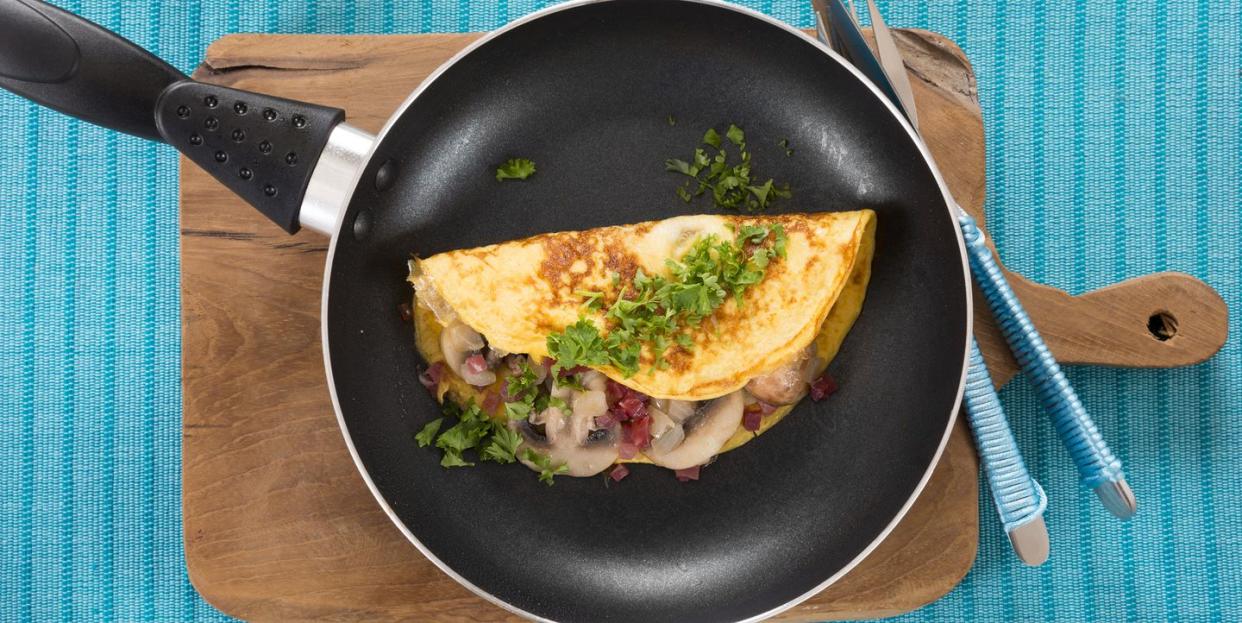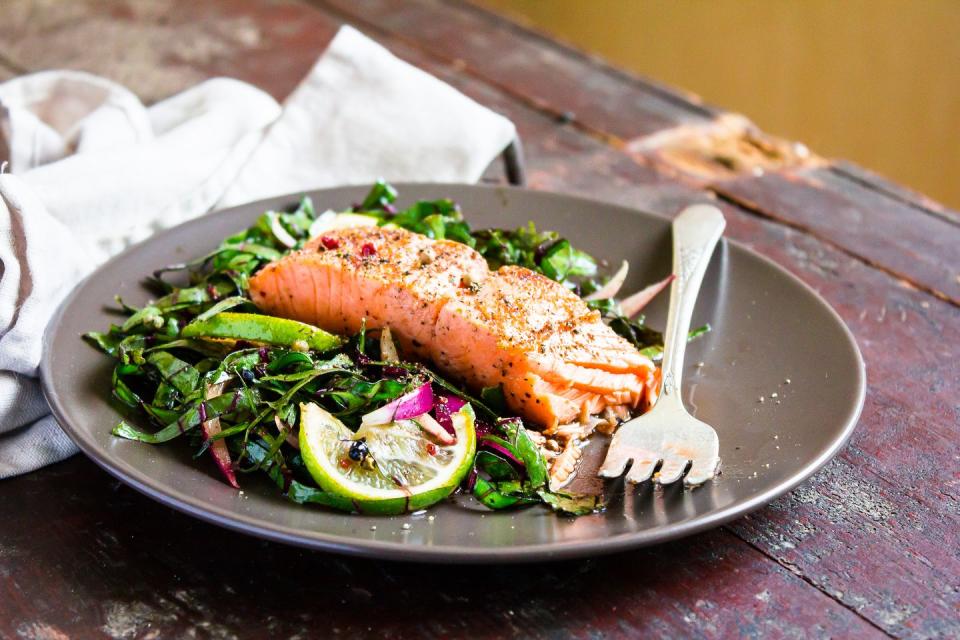Is the Atkins diet the solution to rapid weight loss?

If you're hoping to drop a dress size and you've done your research, chances are you'll have come across the Atkins diet. First promoted in the 1960s by cardiologist Robert C Atkins, the Atkins diet involves ditching carbs in favour of protein and fats to facilitate rapid weight loss.
As a restrictive diet it has received some criticism with experts warning it is unsustainable and may be dangerous if used as a long-term fix, but several studies have also found that the Atkins diet improves blood sugar control and lowers cholesterol, so the jury is currently out.
We speak to dietitian and nutritionist Susie Burrell about what the Atkins diet is, how it works to help you lose weight and the potential risks:
What is the Atkins diet?
The Atkins diet is a low-carbohydrate, high-protein diet designed for dramatic weight loss. The eating plan involves four different phases: induction, balancing, fine-tuning and maintenance.
Most people follow the Atkins diet to lose weight. However, the diet is also promoted as a lifelong approach to eating that may help maintain weight loss, boost energy levels and reduce the risk of some health problems, such as high cholesterol and high blood pressure.
Atkins diet Vs keto diet
In recent years, the ketogenic diet, or keto diet, has gained popularity. Both keto and Atkins are low-carb diets and may be used for weight loss, blood sugar control and heart health. However, there are two key differences between the two diets:
🍎 The keto diet
the keto diet is made up of 70 to 80 per cent fat, making it lower in protein than the Atkins diet.
🍎 The Atkins diet
On the Atkins diet, you slowly increase your carb intake, unlike the keto diet, which remains very low carb to keep your body in a state of ketosis so that it burns ketones for energy.
The Atkins diet phases
The Atkins diet is split into four different phases to help you reintroduce carbohydrates until you find the right ‘carb balance’ that allows you to maintain your ideal weight.
However, this approach is not compulsory and depending on your goals, you may start at any of the first three phases. Below is a guide to the four phases:.
Phase 1 – Induction
Eat just 20 grams of carbs per day (12-15 grams from cooked vegetables and salad)
At least 115-175 grams of protein-rich food for every meal (up to 225g for taller men)
Phase 2 – Ongoing weight loss
Add nuts, seeds, berries and certain cheeses to your diet
Add 5 grams of carbs per week (up to 40 grams) to find your carb tolerance
Phase 3 – Pre-maintenance
Increase your carb intake by 10g per week (up to 100g)
Add pulses, starchy vegetables, more fruits and grains
Find your ‘carb balance’ for steady weight loss or maintenance
Phase 4 – Maintenance
Continue to eat similar to phase 3
Your fat intake may go down as your carb intake increases
Foods to eat on the Atkins diet
The Atkins diet menu varies depending on which ‘phase’ of the diet you are in. However, the following foods are generally allowed:
Meats: beef, lamb, bacon, chicken, and so on
Fatty fish and seafood
Eggs
Cheese
Low-carb vegetables
Full-fat dairy
Nuts and seeds
Healthy fats, such as olive oil, coconut oil and avocado

Foods to avoid on the Atkins diet
According to the Atkins diet, the following foods should generally be avoided:
Refined sugars
Grains
Diet or low-fat foods
High-carb vegetables
High-carb fruits
Legumes
The Atkins diet sample day
A typical day on the Atkins diet during Phase 1 may look like this:
Breakfast – two-egg omelette with chorizo and avocado
Snack – a handful of olives
Lunch – Tuna salad with lettuce, avocado, tomatoes, radish and a drizzle of olive oil
Snack – 30 grams of cubed cheddar cheese
Dinner – Salmon with cauliflower rice and sautéed kale.
You can find more meal plans here.
Who should follow the Atkins diet?
Burrell recommends the Atkins diet for people who have large amounts of weight to lose and are happy to stick to a strict diet at the beginning to kickstart their weight loss.
‘The best aspect of the Atkins diet is that it will help you drop a few kilos quickly which can be motivating,’ Burrell explains. ‘But long term, it is unlikely to be a sustainable diet.’
Burrell also cautions that like most diets, Atkins is not for everyone. ‘Low carb also does not always work for active people who do not have much weight to lose, or for those with glucose regulation issues including insulin resistance. Here, we often see plateaus quickly on a low carb approach.’
The Atkins diet and alcohol
You can drink alcohol on the Atkins diet, however, it is not recommended for Phase 1. From Phase 2 onwards, you can drink moderate amounts of low-carb alcoholic drinks, such as wine and some spirits (gin, vodka and whisky with diet mixers is recommended).
However, it is important to remember that alcohol slows down weight loss by slowing your metabolism – so, if weight loss is your goal, you may decide to limit alcohol completely.
Can vegans or vegetarians follow the Atkins diet?
It is possible to follow the Atkins diet if you are vegan or vegetarian. However, you should start in Phase 2, and include protein such as eggs, cheese and soy products, such as tofu. Vegans may include seeds, nuts, soy products, high protein grains and legumes.
Is the Atkins diet safe?
The Atkins diet is generally regarded as safe for most people. However, it is not appropriate for everyone and if you are concerned, it is always best to check with your doctor first.
The following people should not start the Atkins diet without seeking medical advice first:
People who take diuretics, insulin or oral diabetes medication.
People with kidney problems.
Women who are pregnant or breastfeeding.
In addition, Burrell warns that there are a number of side-effects you may experience in the initial stages of the diet, such as headaches, weakness and constipation.
‘The first few days can be tough for big eaters as their body adjusts to having far less glucose from carbs around,’ she explains, adding that people with glucose issues may need to have their medication adjusted once they have significantly reduced their carb intake.
Does the Atkins diet work?
Like most low carb diets, you will probably lose weight on the Atkins diet. However, studies show that low carb diets such as the Atkins diet are no more effective than other calorie-restricted diets, and most people eventually put the weight back on.
‘Any diet works when it is followed, the issue is that strict low carb diets are rarely followed long term and most of the time weight loss is regained,' adds Burrell.
So in conclusion, if followed correctly the Atkins diet can be an effective way to lose weight quickly – but keeping the weight off long-term may be the real challenge. If you’re serious about making positive lifestyle changes, research has shown that long term weight loss is more successful when diet and exercise are both implemented.
🍎 If you have any concerns about your health, get the go-ahead from your doctor before starting a new diet or healthy eating plan.
Last updated: 09-11-2020
You Might Also Like

 Yahoo News
Yahoo News 
